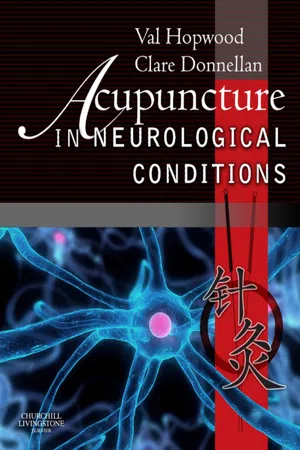KEY POINTS
• The concept of ‘neurology’ is a relatively modern one, with no real place in traditional Chinese medicine (TCM). This is only partly because there is no historical concept of the ‘brain’ in TCM physiology.
• There have been many schools of Chinese medicine: some included ideas that we would recognize as ‘neurology’, whereas others did not.
• The ideas informing the Zang Fu consider different emotions, understanding that they may have a pathogenic influence, and consequently attribute them to appropriate organs.
• There are three syndrome groups that are particularly concerned with neurological symptoms: Bi, Wei and Feng.
• The Bi subgroups are usually defined by the type of Pathogenic invasion but also by the tissue most affected.
• Wei or atrophy syndromes are characterized by limb weakness.
• Feng syndromes are associated with muscle tremor or spasm.
• Acupuncture can often be effective in treating Wei syndromes in their early and middle stages.
Historical development
The combination of the ancient art of acupuncture, part of the equally venerable tradition of Chinese medicine, and what is perceived by Western medicine at least as the most modern of sciences, neurology, seems at first to be quite a challenge. On the one hand we have a tradition of consensus medicine where ideas and theories were handed down from father to son or from master to apprentice and, while there was a great deal of documented debate, no reductionist analysis has been recorded.
On the other hand, the type of evidence required for general acceptance of any medical intervention in our current society, the controlled clinical trial, is relatively new in the world of acupuncture and, while there is an explosion of work in the field of acupuncture for pain control, neurological problems have, thus far, been mostly ignored.
One reason for this lies within the relatively alien ideology and structure of Chinese medicine, but equal blame lies within the fundamental ideologies of Western medicine. Neurology is a complex branch of medicine but tends to be described in two dimensions, being either ‘on’ or ‘off’, like an electrical circuit.
Another very good reason for the relative lack of research into acupuncture and neurological conditions is the complexity of the symptomatology and sheer difficulty of isolating a homogeneous patient group of sufficient numbers to be accepted as a definitive randomized controlled clinical trial.
The history of acupuncture is a long and complex one. It is not necessary, perhaps, to understand every detail but it is very useful to understand how the thoughts of the ancient sages can inform the modern practice of acupuncture. There is an inherent difficulty even in the preceding statement in that actually knowing what is meant by some of the terms is very difficult. Terms gain their meaning through context and the historical contextual background is further complicated by influential modern schools of thought. For instance, the teachings of Worsley, an originator of much of the modern Five-Element theory, lay great emphasis on the ‘Spirit’ of the acupuncture point, even though there is little agreement among Chinese scholars as to what is meant by the term ‘Spirit’ or even what exactly was meant by the names of the points. The possibility for confusion is built in from the start of recorded ideas.
While many Chinese characters can have more than one English equivalent, a majority are well suited by one term. Most sources translate Shen as Spirit, so the question is, what do we really mean by this term? The Chinese context of Spirit is an integral part of the paradigm and, as difficult as it may be to understand, we must make the effort. Otherwise, we only superimpose our own cultural attitudes and beliefs on Chinese medicine.
The seminal written accounts of Chinese medicine theories are over 1000 years old and even in our own culture we are aware of the subtle changes in meaning of seemingly simple words and concepts. The word ‘gay’ would be a good example; it raises no eyebrows when it occurs in the writings of Jane Austen, for example, but when included in today’s prose it would be interpreted rather differently.
Chinese medicine has been used over many hundreds of years. It has a long recorded history: the first written records, the Huang Di Nei Jing, date from about 200 bc. It has evolved as part of the traditional Chinese medical paradigm, together with Chinese herbal medicine. The origins of traditional Chinese medicine (TCM) are closely associated with demonology and ancestor worship, this being usefully d...
